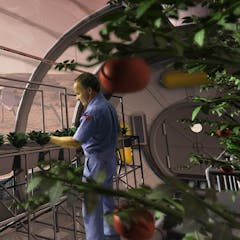
Articles on Cyanobacteria
Displaying 1 - 20 of 22 articles

Over two billion years from now, Earth will no longer be able to sustain life. A new study looks at how much life has ever existed and what this means for the discovery of new life-supporting planets.

Plants aren’t always as good at photosynthesis as you might think. Our research project wants to help them.

‘Living materials’ made with genetically engineered bacteria and Jell-O-like gel could make pollutants in water bodies nontoxic.

An unusual lake with distinct layers of low-oxygen and high-iron water lets researchers investigate conditions like those in the early Earth’s oceans.

To fully understand the extent of climate-related dangers the Arctic – and our planet – is facing, we must focus on organisms too small to be seen with the naked eye.

The Earth isn’t permanent, but it was here for four billion years before humans arrived and should be here for several billion more.

Fossil evidence of how the earliest life on Earth came to be is hard to come by. But scientists have come up with a few theories based on the microbes, viruses and prions existing today.

Ancient rocks from Western Australia may not contain the world’s oldest fossils – but they do preserve organic compounds that may have formed the raw materials for the first living cells.

Agricultural technologies to grow food on Mars can help address climate change, sustainability and food scarcity challenges.

Lakes in the northern hemisphere are rapidly losing their ice cover due to rising greenhouse gas emissions. The only way to preserve lake ice is to limit GHG emissions and slow down climate change.

Pollution from more frequent floods and wildfires – exacerbated by the warming climate – is threatening human health and poses particular risks to the brain.

A networked array of sensors could warn drinking water utilities in real time of harmful algal blooms and prevent public health crises.

Researchers are turning microbes into microscopic construction crews by altering their DNA to make them produce building materials. The work could lead to more sustainable buildings.

Discussions about climate change often skirt around the issue of population growth, but it is the main driver of rising carbon dioxide levels and many other environmental changes on a planetary scale.

Bio-based plastics made from natural sources break down more easily than conventional plastic, without producing toxic byproducts. But for this to happen they have to be composted, not buried in landfills.

Did you recently hear news that Earth’s oldest pigments were hot pink? That’s not quite right. When they were in living bacteria a billion years ago, they were performing photosynthesis – and green.

Following NASA’s latest discovery of organic matter on the red planet, new findings in a salt lake in California could point to where to look for alien life.

A toxic chemical produced by algae and linked to motor neuron disease has been detected in NSW rivers. Its presence - long suspected but now confirmed - could be linked to a disease hotspot in the Riverina.

The possible culprits are: a sudden algae bloom; a change in pool alkalinity; or a chemical reaction in the water. How do these cause a change in the colour of the water?

With El Niño ramping up, Australia is in for a long, hot, dry summer - perfect conditions for blue-green algae. And that innocuous-looking pond scum can pack a toxic punch if you’re not careful.
